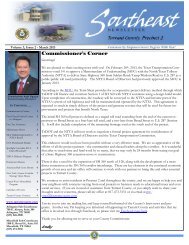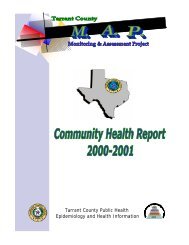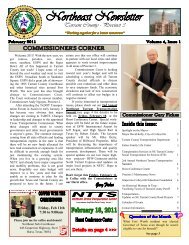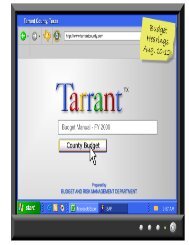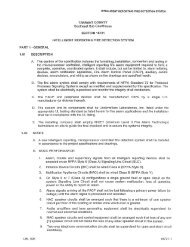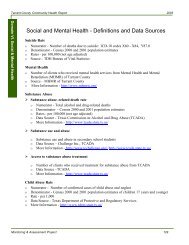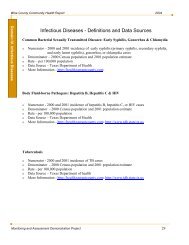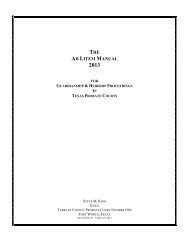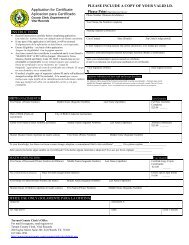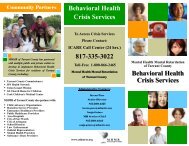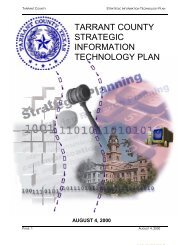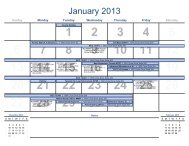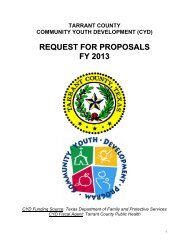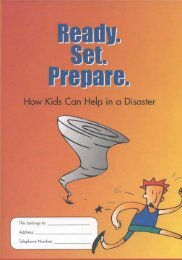MAPP Handbook - The National Association of County and City ...
MAPP Handbook - The National Association of County and City ...
MAPP Handbook - The National Association of County and City ...
You also want an ePaper? Increase the reach of your titles
YUMPU automatically turns print PDFs into web optimized ePapers that Google loves.
Vision Brainstorming <strong>and</strong> Development<br />
Once participants are comfortable with the topic <strong>and</strong> with each other, the dialogue<br />
should be moved toward discussing a vision for the community. Questions should be<br />
formulated beforeh<strong>and</strong> to drive this discussion. Useful visioning questions might include:<br />
1. What does a healthy county mean to you?<br />
2. What are important characteristics <strong>of</strong> a healthy community for all who live, work,<br />
<strong>and</strong> play here?<br />
3. How do you envision the local public health system in the next five or 10 years?<br />
Responses to these questions should focus on broad concepts, not details. Responses<br />
can be collected through brainstorming activities or by writing ideas down <strong>and</strong> then<br />
sharing them. This activity can be organized to gather information through small group<br />
processes, or the group as a whole can address the questions.<br />
Possible approaches for brainstorming include:<br />
• Ask each person to write down what she or he believes about healthy<br />
communities. <strong>The</strong>n ask participants to pair up, share their thoughts, <strong>and</strong> develop<br />
a joint list. Participants should clarify each other’s ideas <strong>and</strong> discuss any<br />
conflicting information. <strong>The</strong>n each pair can join another pair <strong>and</strong> repeat the<br />
process. <strong>The</strong> process is repeated until the entire group is back together.<br />
• Ask each participant to write down her or his ideas. <strong>The</strong>n, in round-robin<br />
fashion, go around the room, posting all ideas on a flip chart (this can be<br />
shortened by limiting the number <strong>of</strong> ideas <strong>of</strong>fered per participant). After all ideas<br />
are shared, the group discusses <strong>and</strong> organizes them.<br />
• Distribute small pieces <strong>of</strong> paper <strong>and</strong> ask participants to write down their ideas—<br />
one idea on each piece <strong>of</strong> paper. <strong>The</strong>n have participants tape their ideas to a<br />
wall. A small group then moves the ideas around until common ideas are<br />
grouped together. List <strong>and</strong> discuss the common ideas.<br />
Values Brainstorming <strong>and</strong> Development<br />
Once ideas have been gathered <strong>and</strong> there is consensus about the concepts<br />
contained in a community vision, the group can move on to identifying common<br />
values (this may be done in the second part <strong>of</strong> the first session, or during a second<br />
session). It is strongly recommended that a small task force or staff group draft the<br />
actual vision statement.<br />
<strong>The</strong> values brainstorming process should be similar to that used when creating the<br />
vision statement, <strong>and</strong> can use the same brainstorming techniques. Questions to elicit<br />
thoughts on common values include:<br />
1.Taking into consideration the shared vision that has been developed, what are the<br />
key behaviors that will be required <strong>of</strong> the local public health system partners, the<br />
community, <strong>and</strong> others in the next five to 10 years to achieve the vision?<br />
2.What type <strong>of</strong> working environment or climate is necessary to support<br />
participants in performing the above behaviors <strong>and</strong> in achieving the vision?<br />
30



